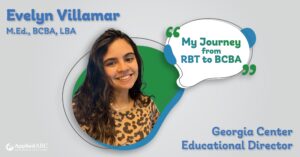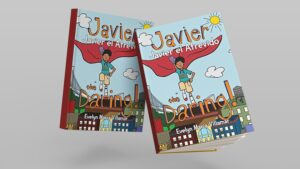
My interest in autism spectrum disorder (ASD) began with the diagnosis of my brother. It was the early 2000s, and we had no idea what this diagnosis was. And in general, it felt like no one really knew what to do to help him. He was five, and I was 16 years old. Our family was utterly lost on what to do next.
How an Autism Diagnosis Affected My Family
I remember that my brother’s autism diagnosis impacted my family significantly because of the lack of information and support for bilingual families. My father wasn’t born in the United States, and Spanish is his dominant language. There was no one to explain what this diagnosis was or how it would affect my brother in our mother tongue.
We had difficulty understanding what ASD was, how it’d impact my brother, and visualizing what the future was going to look like.
My brother had very classic signs of autism spectrum disorder. He could say a few words, but they weren’t super clear. He also engaged in a lot of maladaptive behaviors like biting himself or banging his head against a surface when he was frustrated because he was unable to communicate his needs and feelings with others.
I remember my parents not knowing how to tell people or talk about my brother’s challenges because they were afraid of being judged by family, friends, and the broader community.
Then it became our new normal. We all realized that he thinks and communicates differently. For example, he could memorize Pixar movie scripts from beginning to end and tell us when the films were released on VHS, DVD, or in the theaters.
He’d use the phrases that the characters would say in the movie to communicate what he’d want to say to the world – he was essentially scripting, but he needed to find a way to take what he knew and make it his own and eventually with hard work he did.
Finding My Passion: Helping Children with ASD
Autism is something my family and I have always wanted to learn more about. I was on track to graduate with a degree in sociology and women’s studies at Stony Brook University in New York – not knowing that there was anything out there to specifically help children with autism spectrum disorder.
During registration, we’d receive notifications about new areas of study that would be added to the curriculum. One of those majors was a degree in health science with a concentration in disability studies. I was so excited that I nearly ran to my academic counselor’s office to find out if there was a way to get into the program. She told me that I’d have to stay for an extra year.
The extra year was worth it, and during that time, I started an internship where I shadowed an Occupational Therapist. The Occupational Therapist was essentially running a Social Skills Group (SSG). where pre-teens with ASD would play board games and chat with each other. I learned a lot of cool things from her. I had found my calling; I’d become an OT.
Helping Children with Autism: Getting Started in a Charter School
After I graduated, I needed to find work. If I wanted to go back to school to do OT, I needed a way to pay for it.
I knew that whatever it was that I was going to do, it needed to involve helping kids with autism.
I did a quick Google search, and the first result was a charter school in East Harlem, New York. The more I read about the school, the more I knew that this was my path forward.
This school was only for kids with autism and was housed inside a typical elementary school. The charter school partnered with the elementary school, and the kids who could attend regular classes would go during the day. They also had separate classes for children to learn prevocational and daily living skills through 1:1 ABA therapy for around eight hours a day; it was wonderful.
This is where I learned what a BCBA and applied behavior analysis were. This job helped establish a great foundation for me.
But I was young, and I felt like I was a little bit lost – how could I have already found my niche this early?
I worked for the charter school for five years, and I learned so much. I became a lead instructor and was going for my master’s degree in special education to have the certification I needed to become a head teacher. After that, I’d get my BCBA.
Right away, I knew that this was not for me. I didn’t want to be a teacher. I didn’t enjoy the coursework and felt like I couldn’t do my own thing. So, I put my studies on hold for a long time. I thought I’d wait and see what’s out there. There had to be a way I could do ABA outside of a school setting.
Getting Started as an RBT
Soon after, I was expecting my first child and knew I couldn’t work in the school anymore. The hours were demanding, and I knew it was time to move on. So, I started looking around, and one of my mentors suggested that I look into becoming a registered behavioral technician (RBT). Being an RBT meant I wouldn’t have to work in a school setting. Because it was home-based, I could start working directly in a one-to-one environment with children diagnosed with autism.
In 2013, I started working as an RBT.
It was great; I was working per diem and making decent money on my own schedule. As a new mother, it was fantastic.
I quickly fell in love with the families I supported. And I really enjoyed being able to see the day-to-day difference that I was making in the home. It’s one thing to practice ABA therapy in a controlled school setting; it’s another thing to do it in a home-based setting where every day is different.
From RBT to BCBA
I didn’t become a BCBA until 2017. I was very hesitant because I didn’t want to lose that one-to-one connection with the children. It was also a lot more responsibility, and I would have to oversee a lot more cases without getting to know them in the way I was accustomed to.
I knew I had all this knowledge, but I was scared. I didn’t know if I was going to be effective in a supervisory role. I was also worried about whether my parents would take me seriously.
In 2017, I was expecting a second baby. Despite my hesitancy, my mentor, a BCBA that I had known for years, encouraged me to study and take the exam. Coming in, I was nervous about passing; I had heard horror stories and rumors about people who had to take the exam over and over again until they could finally pass.
Applied ABC reached out to me regarding a unique BCBA position that would allow me to gain a lot of back-end knowledge and work with clients while attaining hours for my New York State license. I have been working with Applied ABC since December 2018 and have taken on many roles, yet none have ever come close to how much I loved being a BCBA.
Even today, I try hard to build relationships with parents. I want them to trust me. I’m very easygoing. At no point am I entering your home to judge. Together, I want to find a resolution that will make things easier. My goal is to be the person that my family needed when we first received my brother’s diagnosis.
Parent training is one of the things I really like about being a BCBA. I try to find a way to help the parents that are already eager and have a notebook open, ready to learn. I also enjoy helping parents that may be more reluctant to learn. I want to be a breath of fresh air and find a way to present information in a way that is both comfortable and rewarding.
I also really like to see the passion when an RBT is really into their work. I feed off that energy and continue to give and teach them everything I know.
Javier the Daring: A Children’s Book for Kids With ASD
In one of my classes during my Master of Education, we needed to create something that would make teaching a concept to a child with a disability easier. So, I wrote a book. After I presented it, my professor stood up and said it was amazing. Many of my classmates, who were already teachers, said they would have really loved having it in their classrooms and to get the work published.
It never happened. I put it on my bookshelf until I recently participated in a self-educational workshop. In it, they recommended taking something up that was “sitting on the shelf,” something that you’re fearful about or scared won’t succeed. I thought maybe it was time to reopen that book.
I wanted to change the concept because my thoughts were now on my family, and what I’ve encountered with the families I work with.
I was often put on cases with families of color – either Latinos or Black Americans. Representation matters, and when your therapist also shares some of the same traditions or culture as you, then you feel more comfortable about what’s going on and more willing to become a part of the team.
There’s less of a fear of judgment. And I felt like there was a theme amongst many of them about not sharing an autism diagnosis with family members because they were scared about being criticized or that family members wouldn’t understand.
My goal was to not only make it sound and look like a children’s book but also give people in the Latino community a way to hear and talk about autism in a positive and hopeful way.
My book is called Javier the Daring and is written in both English and Spanish. Javier, the main character in the book, is a combination of all the kids I worked with as an RBT. You can check out my book here.
If you’re ready to start your own journey, take a look at our job postings.




